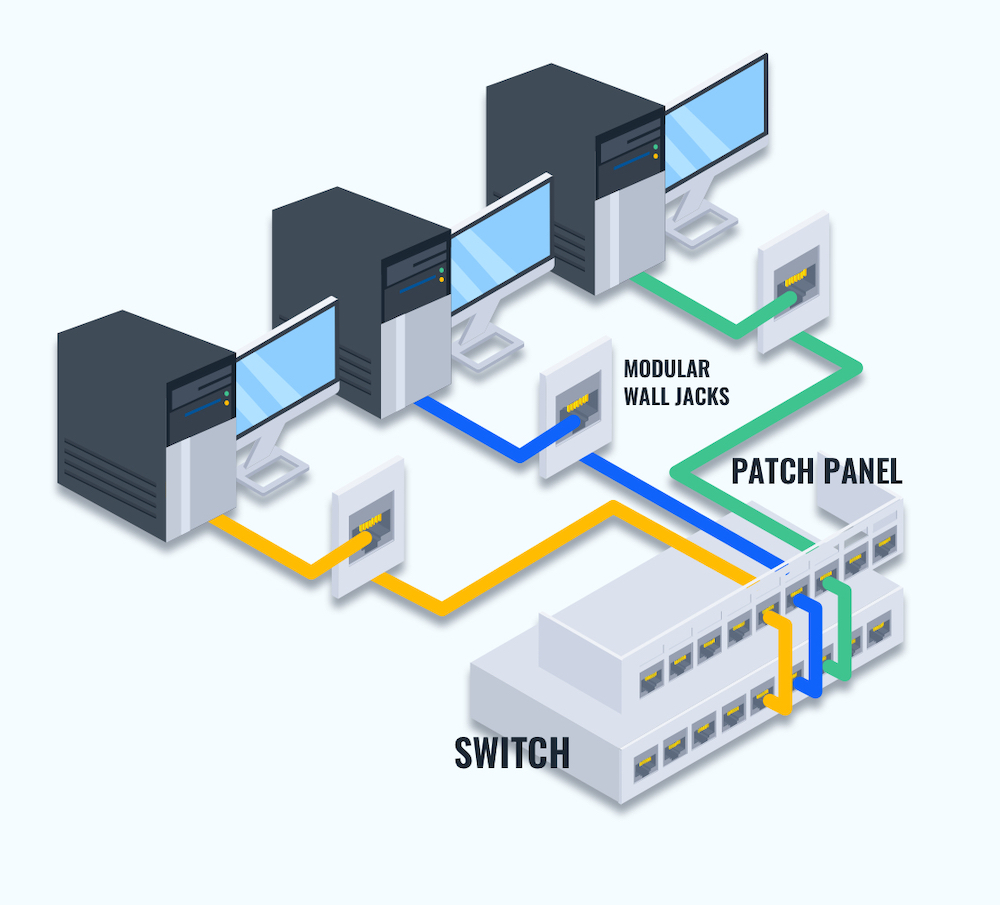What is a patch panel and what is it used for?

What is a patch panel and what is it used for?

Patch panels are important network components that aid in the connection, organization, and overall management of network cables. Let's talk about what exactly a patch panel is and why you should learn about it on the Network+ exam.
What is a patch panel?
Patch panels are the ultimate tool for network organization. It serves as a central point to neatly label and route all cables. Network managers use patch panels to avoid kinking of CAT5 cables in local area network (LAN) sheds.
Patch panel explained
As shown in the figure below, a patch panel is located within a telecommunications cabinet between a switch and the multiple workstations connected to it.

The patch panel will screw into the same rack as the switch, allowing short cables to be run between the switch and the patch panel.
Speaking of cables, patch panels are designed to accommodate a variety of cable types. For example,
Patch panels are manufactured to facilitate Cat5e, Cat6, Cat6a and fiber optics.
Finally, patch panels come in different sizes. Typically, there are 12, 24, 48, or 96 ports on it.
What is the purpose of patch panel?
Patch panels serve as a centralized point for organizing and managing multiple network cables, allowing for efficient connection and easy reconfiguration of devices in a network setup.
They also provide an excellent way to separate the actual cabling from the expensive hardware used to route the data.
Additionally, it enhances cable management, simplifies troubleshooting, and provides documentation and traceability for all workstations.
Hopefully the purpose of the patch panel is clear. Now let’s delve into when to use it.
When should patch panels be used?
When determining the necessity of a patch panel, many factors must be considered. For example, consider network size. If your switch has more than a dozen connections, it might be time to invest in a patch panel.
Furthermore, if you plan to expand your network or have a strong desire for organized cables, then patch panels will be the right choice.
Generally speaking, patch panels should be used in any network with rack-mounted hardware.
How do patch panels work?
Of all the network components, patch panels are probably the simplest in how they work. In its purest form, a patch panel is simply a tool that facilitates cable organization and documentation. It's not as complicated as a switch.
Typically, the patch panel is located directly on top of the switch. The cable enters the patch panel from the back and then connects to a router or switch on the front of the device with a very small cable.
It separates this function from the switch, preventing cables from being frequently disconnected and redirected from critical traffic management devices. The most important role of patch panels is to manage physical connections.
Patch panels manage physical connections
The most important responsibility of a patch panel is to manage physical connections. This is terminated by providing a single centralized area for all cables.
If you decide to bypass the patch panel and plug all your devices directly into the switch, you'll need to use a lot of long cables running directly from the workstation to the switch. Since the switch ports are mounted on the front, it can quickly get out of control and become a mess.
Additionally, patch panels allow for labeling. This helps administrators know exactly which cable is connected to which workstation. All in all, it is better to use a patch panel!
Will patch panels reduce signal strength?
No, the patch panel itself does not degrade signal quality. However, improper cable length, quality, and termination can all cause signal attenuation. For example, poorly crimped Cat5 cable will play a significant role in signal attenuation, while a patch panel will not. Recall that a patch panel is simply a non-electronic component used to manage and organize cables.
Speaking of Category 5 network cables, let’s first review the differences between Category 5 and Category 6 patch panels.
What is the difference between Cat5 and Cat6 patch panels?
While these two patch panel types are certainly not the only ones, they are the most common. Although the difference is small, it is certainly worth noting.
Cat6 cable was introduced in 2002 to improve existing Cat5 cable. Currently, most LANs run on Cat5e or Cat6, with Cat6 being the best cabling solution.
Difference in transmission speed of patch panel
The speed difference between Cat5e and Cat6 through a patch panel is determined by the specifications of the cable itself, not the patch panel.
For example, both Cat5e and Cat6 can transmit 1 GB of data per second over a range of 100 meters. However, Cat6 can transmit up to 10Gbps over a distance of 55 meters
The data. Therefore, it is technically the better choice when it comes to high-speed internet over relatively short distances. (Although 55 meters is not a short distance in an office building.)
This means that the transmission speed has little to do with the patch panel. Rather, it is the specification of the cable that runs through them.
Are there different wiring standards for patch panels?
Yes, patch panels have different wiring standards depending on the cables they are intended to accommodate. Wiring standards determine how the individual wires in an Ethernet cable are terminated to the connectors on the patch panel.
The two most common wiring standards for Ethernet cables are T568A and T568B. You can use either Ethernet wiring standard as long as it's consistent.
However, be sure to consult the patch panel's documentation to confirm if there are recommended wiring standards.
If T568A and T568B are interchangeable Ethernet cabling standards, does that mean Cat5 and Cat6 are also interchangeable? Let's take a look.
Are Cat5 and Cat6 patch panels compatible?
Yes, Cat5 and Cat6 patch panels are compatible. They all follow the same Ethernet standard. The only differences are specs and speed. One thing to remember is that your LAN is only as fast as the slowest cable.
In other words, if you mix and match Cat5 and Cat6 cables, your LAN will only be as fast as the Cat5 connection.
This guide means that it is generally a better idea to build a LAN using Cat6 as it is much faster. On the other hand, if it's a traditional LAN, stick with Cat5 if you can get it cheaper. You don't enhance your LAN by throwing in Cat6 occasionally.
Next, let's take a closer look at the interaction between switches and patch panels.
What is the difference between patch panels and switches?
The difference between a patch panel and a switch is that a patch panel is a tool that organizes cables near the switch. Instead, switches are responsible for routing network traffic.
A switch is a physical device that requires power and serves as the primary routing mechanism within a LAN. In contrast, patch panels are components close to the switch that facilitate easy and traceable access to the switch.
Switches are active network devices
Switches are active network devices that perform all the heavy lifting on the LAN. A patch panel is just a tool for organizing cables. If the switches are Christmas lights, then a patch panel will be an organizational tool to ensure they don't turn into a giant knotted ball by the next holiday.
Patch panel passive cable management equipment
Patch panels offer the advantage of labeling and organizing network cables. They are typically mounted on the top of the switch and provide labels or color codes to indicate the location of the connected workstations.
Patch panels are not routing traffic
As mentioned before, it is important to understand that patch panels do not route traffic. Switches, routers, and gateways Routers do all this work.
However, since patch panels are so simple, they are cheap. A patch panel typically costs between $20 and $100, depending on its size.
For example, a patch panel with 16 port openings costs significantly less than a patch panel with 48 port openings. Not only are they cheap, but they can be customized to a considerable degree with cornerstones. Let’s discuss how you can increase the flexibility of your patch panel by adding keystone correction.
What is Keystone?
Keystone is a connector used with patch panels and wall panels, and can be used with other connection types. For example, the network may require a phone line to be connected to a router that only accepts Ethernet. Keystone will attach to the wall plate for easy transition from RJ11 to RJ45 connections. Overall, this will simplify network reconfiguration and maintenance.
Distribution frame and Keystone
As far as patch panels and Keystone are concerned, patch panels are the centralized point for connecting and managing various cables. In contrast, Keystone is an adapter designed to plug into a patch panel. Keystone acts as an adapter in situations where the connected device does not have an Ethernet port (or whatever port type is required).
Patch panels are centralized equipment
The patch panel assembly sits directly above the rack and plugs into the router using very short cables that run from the patch panel to the router. The initial connection point for each workstation on the network is the patch panel.
Keystone, on the other hand, is used to allow devices that would otherwise not be able to connect to patch panels.
Keystone (jack or module) connecting cable
Let's start with a basic example to express the usefulness of the keystone module. Let's say your organization is a mix of Ethernet-connected devices and POTS (plain old telephone service). POTS needs to have RJ11
Adapter for traditional phone lines, while Ethernet cable requires an RJ45 connection. However, your switch only has RJ45 ports. This is where the keystone module comes in.
You can mount the RJ11 adapter's keystone module directly to the wall to connect all your phone lines. This will route CAT5 or Category 6 cable directly to the patch panel. This way your POTS can be routed into the network while still having the exact same switch. The same basic principle applies to any other type, whether HDMI, USB, USB-C or other.
keystone can be installed into patch panels
In the previous example, we discussed adding a Keystone module to the outlet into which the device is plugged. However, sometimes Keystone can be installed directly into the patch panel.
Keystone modules in patch panels provide the flexibility to adapt to your connectivity needs without the need for a monolithic network infrastructure. For example, if Keystone is mounted on a wall panel, that specific device can only be used in that room.
However, if the Keystone module is located in a patch panel, the ports can be switched very easily. This is especially beneficial for large network setups.
Advantages and Disadvantages of Patch Panels
As with everything, patch panels have some pros and cons. Let’s discuss and decide if a patch panel is right for you.
Patch panels help manage cables
The number one reason to buy a patch panel is to help manage cables. Talk to anyone in LAN management—novice or veteran—and they'll tell you that cables can quickly become a tangled mess.
The patch panel also features keyholes, allowing you to connect different cables to the switch that would otherwise be incompatible. This solution is ideal for legacy POTS networks or where fiber needs to be converted to CAT6. Next, let’s move on to patch panels and flexibility.
How patch panels improve flexibility
Patch panels allow you to insert cables from the back of the rack and then connect a short connector cable (no longer than a foot) to the switch. So when you need to switch between different ports, you only have to deal with a tiny one-foot cable.
Without a patch panel, you'd be forced to replace a cable that's up to 100 feet long. Additionally, the router doesn't have a system in place to mark where the cables go. The patch panel is built on top of the port.
Patch panels might help meet future needs?
The patch panel itself does not guarantee the future development of the network. However, they provide an excellent way to decouple cable management from critical resources such as switches or routers. This means upgrades will be less of a hassle and will greatly aid the network's future-proofing efforts.
For example, having patch panels will make upgrading CAT cables much easier, and will certainly make replacing switches a breeze (from a cable management perspective).
Patch panel costs, including maintenance
The initial cost of patch panels is not expensive. They can cost up to $200 for devices with multiple ports, but they can certainly be found cheaper. The true cost of patch panels will come from labor. Installing a patch panel is a relatively complex process that involves rack mounting, cable crimping, and cable labeling.
However, the cost is worth it with the increased uptime, cable organization, and ease of future maintenance. Finally, once installed, maintaining the jumpers requires very little work.
Patch Panel Complexity and Space Requirements
Before purchasing a patch panel, make sure there is enough space above or below the switch to install it. The patch panel must be as close as possible to the switch.
However, the cost is worth it with the increased uptime, cable organization, and ease of future maintenance. Finally, the jumpers require minimal effort to maintain after installation.
Patch Panel Complexity and Space Requirements
Before purchasing a patch panel, make sure there is enough space above or below the switch to install it. The patch panel must be as close as possible to the switch.
Also, think carefully about how you want to use Keystone. They plug directly into wall panels or patch panels.
Finally, make sure the front and back of the patch panel are easily accessible. If an outage occurs, you don't want to spend too much time working on the back of the patch panel.
Signal attenuation and maintenance associated with patch panels
The patch panel itself does not cause signal attenuation, but improperly installed cables may. For example, loose cables on the back of a patch panel can cause unnecessary delays in the network. When wiring your network, verify that the cables are of high quality and do not have any crimps or cuts in the wires.
Overall, routine maintenance and following best practices for cabling and maintenance can help prevent problems that can affect signal quality. If there is signal attenuation in your network, the signal is not coming from the patch panel unless the cable has a bad crimp.
in conclusion
We do a lot of work on patch panels. By now, you're ready for whatever information Network+ has to offer you about patch panels. Here are the key points:
- Patch panels are centralized solutions that assist with cable management.
- They provide flexibility by allowing LAN administrators to easily replace cables.
- Patch panels allow logging and tracking of workstation cables.
- They are inexpensive but relatively time-consuming to set up.
Hope you have some ideas on how to improve the maintainability of your network!